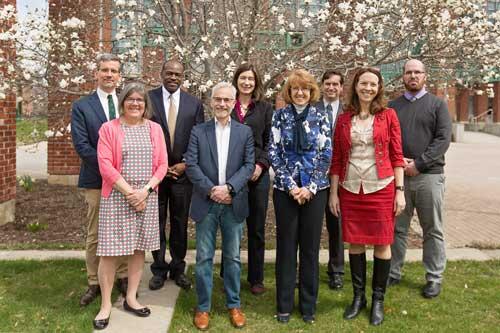
The WIG team includes, first row, left to right: Sue Chichester, Paul Schacht, Kathy McIntyre, Stacey Robertson. Second row, left to right: Bill Harrison, Enrico Johnson, Julie Rao, Joe Cope, and Ben Rawlins. Not pictured are members Anne Baldwin, Celia Easton, Tony Hoppa, and Ken Kallio. (SUNY Geneseo photo/Annalee Bainnson)
With an acronym like WIG, there is no shortage of puns to describe the new initiative underway within the Division of Academic Affairs’ Office of the Provost. Yet, the “Wildly Important Goal” is serious business for the 13-member team, which aims to increase Geneseo’s first-year/ first-time-to-college to second-year student retention rate from 86 to 88 percent by October 2019.
Introduced by Provost Stacey Robertson, the WIG initiative began last fall as a team book-reading exercise using the Wall Street Journal business bestseller, The 4 Disciplines of Execution, by Chris McChesney, Sean Covey, and Jim Huling. Based on extensive research, the authors set forth a methodology and process known as 4DX to help organizations achieve their wildly important goals by identifying, measuring, and scoring lead measures that can be affected by specific actions or behaviors to create change and positive results.
In addition to Robertson, team members include Anne Baldwin, Sue Chichester, Joe Cope, Celia Easton, Bill Harrison, Tony Hoppa, Enrico Johnson, Ken Kallio, Kathy McIntyre, Ben Rawlins, Julie Rao and Paul Schacht. The group convened in early January for a planning retreat to discuss the book’s findings and to brainstorm potential opportunities to apply 4DX to a specific Geneseo challenge. Adhering to a key tenet of the 4DX program — there can be no more than two wildly important goals deserving of a team’s energy and focus — the group chose retention as its WIG of choice.
“Reading this book together was not only a teambuilding exercise but it was also a mini-business class that helped us realize why so many good ideas fail to be executed successfully,” Robertson said. “The answer is on page six:”
“The real enemy of execution is your day job! We call it the whirlwind. It’s the massive amount of energy that’s necessary just to keep your operation going on a day-to-day basis; and ironically, it’s also the thing that makes it so hard to execute anything new. The whirlwind robs from you the focus required to move your team forward.”
“Our team identified several compelling opportunities, but we agreed that at this moment in time at Geneseo, and within our respective spheres of influence, efforts to improve retention could make a dramatic difference in both the lives of our students as well as the College’s bottom line,” Robertson explained. “While there may be valid reasons beyond our control that cause a student to leave Geneseo, our WIG is to make sure that we’re doing everything possible in Academic Affairs to deliver an outstanding educational experience that keeps students engaged, successful — and excited to return to learn more.”
Every Wednesday, team members step away from their daily whirlwind to meet briefly and report on their WIG commitments. Each is expected to accomplish action items identified within one or more of six categories of lead measures relevant to a member’s area of expertise and responsibility, which, when executed, will help “move the needle” to achieve the retention goal. These measures are professional development, awareness/communication, digital solutions, student support services, right-sizing/access, and applied learning.
To overcome the whirlwind, the group is committed to practicing the four disciplines by 1) focusing on the wildly important, 2) acting on the lead measures, 3) keeping a compelling scoreboard, and 4) creating a cadence of accountability. Though the team embraces individual responsibility, the process is collaborative and could not occur without the ongoing support and contributions from colleagues and administrative leaders across the College.
The authors’ research points to five stages that teams will navigate when implementing the 4DX program: getting clear, launch, adoption, optimization, and habits. Robertson sees the team at the adoption stage.
“Getting started is often the toughest hurdle when teams embark on something new,” Robertson observed. “We’ve only been at this for one semester, but already we’re speaking a common language and building a culture that will allow us to not only do our best work within the whirlwind, but in spite of it. It’s not an ‘either/or’ choice: We’re very confident that we will achieve our WIG and increase retention.”
– Tony Hoppa